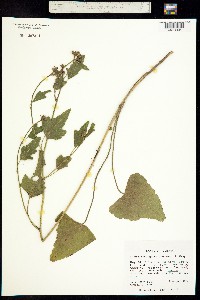Callirhoe triangulata
|
|
|
|
Family: Malvaceae
Clustered Poppy-Mallow
[Malva houghtonii Torr. & A. Gray, moreMalva triangulata] |
Perennial herb 40 cm - 1 m tall Leaves: alternate, long-stalked, round-toothed, rough-hairy, elongate triangular with straight or slightly indented base, though upper ones sometimes with a few shallow basal lobes. The leaves also have persistent egg-shaped stipules at the base of their stalks. Flowers: several, short-stalked, but clustered on longer axillary or terminal stalks, purple-pink, 2.5 - 6.5 cm diameter, radially symmetric with five sepals alternating five spreading petals, and three, rough-hairy, 3 - 8 mm long, spoon-shaped bractlets immediately subtending the sepals. Sepals: five, but fused at base, then separating into five, 2 - 6 mm long, widely triangular, five-nerved lobes. The calyx as a whole is covered with stiff, star-shaped hairs. Petals: five, spreading, purple-pink, with white basal spot, 1.6 - 3.2 cm long, elongate wedge-shaped with narrower base and abruptly flattened tip, which may have a few small irregular teeth. Stamens: numerous, but filaments fused into a tube with anthers protruding above the middle. Pistil: enclosed by the stamen tube, with ten to twenty superior carpels (ovule-bearing structures), ten to twenty slender styles coming up through center of stamen tube, and ending with exserted, slender stigmas facing inward. Fruit: a ball-like structure of ten to twenty, one-seeded, hardened, thin-walled, hairy, fairly kidney-shaped wedges (mericarps) subtended and partially enclosed by the persistent sepals. Stems: ascending to nearly erect, harshly rough-hairy, and arising from a spindle-shaped root. Similar species: Callirhoe triangulata is similar to both C. alcaeoides and C. involucrata, but both those taxa have deeply lobed or incised leaves (at least above), the flowers are single on each long stalk, and the fruit segments are obviously wrinkled and pitted at least on the sides. Furthermore, C. alcaeoides lacks subsepal bractlets below the flowers, and C. involucrata has longer sepals (0.9 - 1.6 cm). Flowering: July to September Habitat and ecology: Rare, in sandy cemeteries in Grundy County, IL, though it may be possible to find it in dry woods and sandy prairies. Occurence in the Chicago region: native Notes: Callirhoe triangulata decreases under disturbance such as grazing, but will return if grazing ends. Author: The Field Museum Stems ascending, 4-10 dm; herbage (including the cal) harshly stellate-hairy; principal lvs chiefly triangular with broadly truncate to cordate base, crenate (seldom some of them cleft), the lower notably long-petiolate; reduced upper lvs often much narrower and/or few-cleft; fls short-pedicellate, several and crowded at the ends of more elongate axillary and terminal peduncles; bractlets 3-8 mm, spatulate or obovate; cal-lobes deltoid-ovate, 2-5+ mm, the tips connivent in bud into a short beak; pet 16-32 mm, red with a white basal spot, entire or slightly erose; mature carpels hairy, thin-walled, not rugose; 2n=30. Sandy prairies; s. Wis. and ne. Io. to Ill., w. Ind., and se. Mo.; irregularly from Miss. to Ga. and N.C. July-Sept. Gleason, Henry A. & Cronquist, Arthur J. 1991. Manual of vascular plants of northeastern United States and adjacent Canada. lxxv + 910 pp. ©The New York Botanical Garden. All rights reserved. Used by permission. From Flora of Indiana (1940) by Charles C. Deam Indiana is included in the range of this species in Gray, Man., ed. 7 and in Britton and Brown, Illus. Flora, ed. 2. There were, however, no specimens in the Gray Herbarium or in the herbarium of the New York Botanical Garden until I sent them specimens in 1933. There are no other reports. In July, 1933, Scott McCoy found it plentiful in sandy soil along the C. E. & I. Railroad about a mile north of Oaktown, Knox County. I visited this place in August, 1933, and found the species well established at three places. An attempt to dig some plants convinced me that it has been there for some time and is doubtless established. ...... Indiana Coefficient of Conservatism: C = 10 Wetland Indicator Status: n/a |














































































